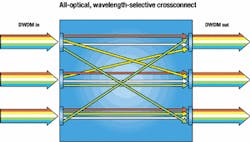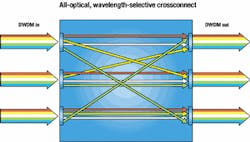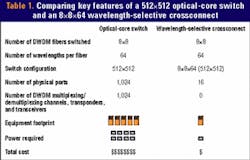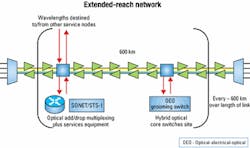1-D MEMS for integrated wavelength switching
One-dimensional MEMS multiplexed switching solutions enable a new paradigm in all-optical networking, making fully functional, highly reliable multiplexed switching possible.
DOUGLAS J. ARENT and BEVAN STAPLE, Network Photonics
As DWDM becomes ubiquitous in long-haul and metro core networks, carriers are looking at optical switching to manage the ever-growing number of wavelengths and automate wavelength routing, restoration, and grooming. To meet these requirements, optical core switches (OCSs) need to scale to accommodate high wavelength counts, high TDM bit rates, and various types of transport protocols such as SONET and Gigabit Ethernet. One-dimensional (1-D) MEMS multiplexed switching solutions enable a new paradigm in all-optical networking, making fully functional, highly reliable multiplexed switching possible while enabling new economic efficiencies required by service providers.
OCSs, better known as optical crossconnects, can generally be classified into three categories: opaque electronic core switch, opaque photonic core switch, and transparent photonic core switch. Opaque, optical-electronic-optical (OEO) OCSs offer the ability to groom services down to subwavelength bit rates such as STS-1 (52 Mbits/sec). This grooming capability results in scalability challenges due to bit-rate limitations and high power consumption of the electronic switching fabric. Furthermore, OEO OCSs are bit-rate- and protocol-dependent (opaque), which limits flexibility and requires forklift upgrades.
Opaque photonic switches combine OEO conversions and optical switch fabrics, addressing the power and scalability issues of OEO OCSs, while remaining bit-rate- and protocol-dependent. In contrast, transparent or all-optical (OOO) OCSs, where no electronic conversion takes place, are bit-rate- and protocol-transparent.OOO switches therefore offer more flexibility to carry diverse protocols and bit rates and are particularly useful in topologies where TDM rates may be upgraded without requiring OOO OCS upgrades. Furthermore, since OOO switches route signals using passive optics (without electrical conversions), their power consumption can be significantly less than equivalent-scale OEO switches.
OEO and OOO OCSs do not necessarily compete with each other. When viewed from a network-wide perspective, both switches offer complementary benefits. OEO switches are best used at the transport edge where grooming of services are needed, and OOO switches are best used in the core of the network where management at the wavelength level is needed.
While multiple technologies are being developed for the core of OOO switches (e.g., bubbles, micro-electromechanical systems-MEMS, and non-linear optical materials such as lithium niobate, holograms, and liquid crystals), MEMS has emerged as the leading technology of choice. Generally, these MEMS switches are classified as two-dimensional (2-D) or three-dimensional (3-D).
The 2-D planar arrays, also known as N2 architectures (since N2 mirrors are required to switch N wavelengths), are now available in low port counts (e.g., 2x2, 4x4, and 8x8). But the 2-D architecture has limited scalability (e.g., 32x32) due to diffraction challenges and limitations on the size of the MEMS die. 3-D MEMS architectures are currently under development in an attempt to achieve higher port counts without sacrificing optical performance.
However, 3-D architectures, also known as 2N architectures (since 2N mirrors are required to switch N wavelengths) pose complex and expensive control and packaging challenges. In 3-D architectures, since each micro-mirror must have multiple stable positions, a sophisticated closed-loop servo system with feedback must be implemented for each mirror to ensure the mirrors move to, and remain in, the desired position.
Using a closed-loop control scheme implies that the beam positions over time, space, and environments must be monitored, actively feeding this information back to the system in a timely fashion. The required 2N servo systems force solutions that are large in size and power consumption and have high costs.
In contrast to optical-core switches, wavelength-selective crossconnects are transparent, optical multiplex-domain core switches that offer significant advantages over OCS-based architectures. As shown in Figure 1, a WXC natively switches wavelengths in the multiplexed domain. The multiplexed DWDM wavelengths enter the WXC and are switched among input and output fiber ports before exiting as multiplexed signals on the desired fiber. Switching in the multiplexed domain eliminates the need for external demultiplexing and multiplexing as well as multiple OEO conversions.
The WXC offers significant fiber management and cost savings by requiring only one port per DWDM fiber, as opposed to a single port per wavelength in OCS-based systems. For example, each fiber in the 3x3 WXC shown in Figure 1 may carry 80 wavelengths, thus the 3x3x80 architecture offers effectively 240x240 wavelength switching capacity but only requires six fiber ports.
As purely photonic crossconnect switching in the multiplexed domain, a WXC has extremely small power requirements-less than 10 W in contrast to many kilowatts for traditional OEO OCSs. By eliminating the external demultiplexing/multiplexing and OEO conversions and reducing fiber-management complexity, the WXC has an extremely small footprint. Because it photonically switches optical signals, the WXC is both bit-rate- and protocol-transparent. Wavelength bit rates may be upgraded at the transport edge (i.e., from 155 Mbits/sec to 40 Gbits/sec), while the WXC does not require any additional operational input or change.Finally, as summarized in Table 1 comparing OCS and WXC configurations, significant cost savings complement all of these advantages. Capital expense costs are reduced through elimination of OEO conversions, closed-loop servo controls, and the required demultiplexing/multiplexing equipment. Operation al costs are also reduced through lower space, power, and management costs. The dynamic nature of the WXC allows remote software control and advanced protection features, offering significant advantages, both from an operational level and the ability to rapidly provision services.
Another technology, the 1-D MEMS, enables all of these advantages. Newly developed multiplexed switching solutions integrate demultiplexing/multiplexing and switching into a single operation, in contrast to other all-optical switch-based systems that require external demultiplexing/multiplexing. This powerful functionality is achieved through a hybrid integration 1-D MEMS and a wavelength-dispersive element.
Within the switch architecture, wavelengths from input fibers are spatially separated by the dispersive element. Each separated wavelength is focused onto the surface of a micro-mirror in the 1-D MEMS array where the switching occurs. The independently switched wavelengths are then recombined into DWDM signals and exit into the output fibers.Another key difference between the 2-D or 3-D and 1-D MEMS switches is the mirror packing density of the die. While 2-D or 3-D MEMS typically occupy much of the real estate on a large silicon die, 1-D MEMS uses much smaller mirrors arranged in a linear configuration, occupying only a small fraction of the die. The result is higher manufacturing yields due to lower susceptibility to contamination and handling damage. In fact, die dimension and layout for 1-D MEMS are driven by packaging needs instead of the mirrors, thereby increasing the yield and reliability of the overall packaged device.
Summarized in Table 2, the key features of MEMS-based optical components indicate the relative advantages and disadvantages among 1-D, 2-D, and 3-D devices. 3-D MEMS devices, while holding strong promise for scalability, offer a number of challenges such as mirror control, packaging complexity, and overall reliability.
Physically, these multiplexed switching solutions are fully athermal, eliminating any requirement for active temperature control and extremely low power (less than 1 W per device). Leveraging 1-D MEMS technology enables production of highly reliable, low-cost optical switching and transport equipment to meet the stringent requirements of the telecommunications industry.
1-D MEMS-based WXCs can address a number of applications in a variety of network topologies, ranging from linear to ring to mesh topologies. In ring topologies, distributed WXCs, centralized WXCs, or ring interconnects, enable wavelength routing, protection, and restoration while eliminating many OEO conversions. Similarly, in mesh networks, WXCs can be applied to OOO wavelength routing. In linear networks, WXCs effectively address two pressing applications: flexible add/drop capability in long-haul (LH) and ultra-long-haul (ULH) DWDM networks and hybrid OCS switching.
One critical challenge in deploying LH and ULH DWDM networks is cost-effectively serving the numerous add/drop sites to the backbone. Since current-generation LH and ULH DWDM network equipment allows all-optical transport up to many thousands of kilometers without regeneration, carriers must address the need to add, drop, or groom wavelengths at network nodes between the end terminals.Figure 3. Shown is an extended-reach long-haul or ultra-long-haul DWDM network with dynamically configurable intermediate add/drop and grooming nodes. The node to the left offers dynamic wavelength routing to/from other service nodes as well as SONET and data services. The node to the right offers dynamically configurable hybrid optical core switch wavelength-grooming services. The intermediate nodes are typically spaced about 600 km apart to serve lower-tier cities and mid-span connection points.
Figure 3 depicts a long-reach DWDM network link, including intermediate add/drop sites. At the intermediate sites, where wavelengths must be flexibly added, dropped, or groomed for appropriate services, the key challenge is to effectively minimize any perturbation to desired express traffic and cost-effectively add, drop, or groom the required wavelengths.
While the required wavelength-level functionality can be addressed with a variety of solutions-including fixed filters, power splitting combined with full demultiplexing and selective extinction, or banded filter architectures-these solutions are neither cost-effective nor sufficiently flexible to address traffic patterns that are neither static nor reliably predictable. Furthermore, cascading multiple elements in a single link requires excellent optical performance, such as flat-top passband and dis persion-free design. Ideally, service providers prefer to deploy a flexible add/drop network element to effectively address low initial cost requirements, low operating expenses, required flexibility, and scalability to handle changing and unpredictable traffic demands.
At the intermediate nodes, the wavelength-selective add/drop crossconnect allows individually addressing any wavelength or set of wavelengths within the multiplexed cross section. That allows dynamic, flexible reconfiguration of express and add/drop traffic. In these configurations, wavelengths can be reassigned from the express path to the add/drop paths with no effect on the wavelengths remaining in the express path.
Functionally, multiplexed DWDM signals enter, are switched among fiber ports, then exit the add/drop WXC as multiplexed signals on the desired fiber. For express traffic, switching in the multiplexed domain eliminates the need for external demultiplexing and multiplexing as well as multiple OEO conversions. This capability directly eliminates 50-70% of the costs of intermediate add/drop nodes when compared to alternative solutions.
For drop traffic, small-wavelength-count demultiplexers or individually tunable receive filters may be used to isolate individual wavelengths from the multiplexed signal. In addition to bit-rate and protocol transparency, extremely low power, and a remarkably small footprint, the add/drop WXC offers significant fiber-management and cost savings by requiring only a single port per fiber where each fiber can carry a large number of wavelengths.
Similar to the wavelength-selective add/ drop crossconnect, hybrid OCS architectures allow dynamic, flexible reconfiguration of express or grooming traffic. In these configurations, wavelengths can be reassigned from the express path to the grooming switch fabric with no effect on the wavelengths remaining in the express path. By selectively grooming only the required services, the hybrid OCS offers both effective wavelength management and cost-effective and appropriately sized grooming capabilities, resulting in lower overall costs, space utilization, and power consumption.
1-D MEMS multiplexed switching solutions enable a new paradigm in all-optical networking, making fully functional, highly reliable multiplexed switching possible, while enabling new economic efficiencies required by service providers. Using a highly integrated architecture of 1-D MEMS and passive optics, advances in high-reliability volume manufacturing can be leveraged. The scalability, reliability, fast switching times, and packaging simplicity of 1-D MEMS technology brings new features to all-optical DWDM networks.
Douglas J. Arent is director of business development and Bevan Staple is a senior MEMS engineer at Network Photonics (Boulder, CO). They can be reached via the company's Website, www.networkphotonics.com.
An expanded version of this article can be found on Lightwave's home page at www.light-wave.com.






